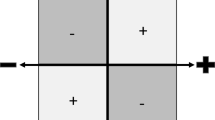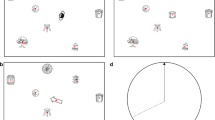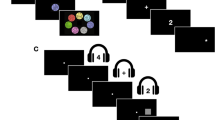Abstract
We examined whether combined motor or spatial polarities could influence accuracy in two mathematical operations. Four experiments were conducted and showed that, when two corresponding polarities were activated, accuracy in multiplicative operations was greater than when non-corresponding polarities were activated, whereas no effect was found for additive operations. These results were established with motor cues (Left/Right and Arm Extension/Flexion, as behavioral approach-avoidance tendencies) and perceptual spatial cues (Left/Right and DOWN/UP cues). A polarity correspondence effect was established and proposed for multiplication. A combination of polarities was associated with a corresponding combination of numerical digits, assessed with mathematical operations, such as multiplication.




Similar content being viewed by others
References
Anderson, N. H. (1981). Foundations of Information Integration Theory. New York: Academic Press.
Anderson, N. H. (1982). Methods for Information Integration Theory. New York: Academic Press.
Anderson, N. H. (1996). A functional theory of cognition. Hillsdale: Lawrence Erlbaum.
Anderson, N. H. (2008). Unified social cognition. New York: Psychology Press.
Anderson, N. H. (2013). Unified psychology based on three laws of information integration. Review of General Psychology, 17, 125–132. doi:10.1037/a0032921.
Anelli, F., Lugli, L., Baroni, G., Borghi, A. M., & Nicoletti, R. (2014). Walking boosts your performance in making additions and subtractions. Frontiers in Psychology Cognition, 5, 1459. doi:10.3389/fpsyg.2014.01459.
Badets, A., Koch, I., & Toussaint, L. (2013). Role of an ideomotor mechanism in number processing. Experimental Psychology, 60, 34–43. doi:10.1027/1618-3169/a000171.
Badets, A., & Pesenti, M. (2011). Finger-number interaction: An ideomotor account. Experimental Psychology, 58, 287–292. doi:10.1027/1618-3169/a000095.
Bae, G. Y., Choi, J. M., Cho, Y. S., & Proctor, R. W. (2009). Transfer of magnitude and spatial mappings to the SNARC effect for parity judgments. Journal of Experimental Psychology Learning Memory and Cognition, 35, 1506–1521. doi:10.1080/17470210802303883.
Cacioppo, J. T., Priester, J. R., & Berntson, G. G. (1993). Rudimentary determinants of attitudes: Arm flexion and extension have differential effects on attitudes. Journal of Personality and Social Psychology, 65, 5–17. doi:10.1037/0022-3514.65.1.5.
Campbell, J. I. D., & Austin, S. (2002). Effects of response time deadlines on adults’ strategy choices for simple addition. Memory and Cognition, 30, 988–994. doi:10.3758/BF03195782.
Carlson, R. A., Avraamides, M. N., Cary, M., & Strasberg, S. (2007). What do the hands externalize in simple arithmetic? Journal of Experimental Psychology Learning Memory and Cognition, 33, 747–756. doi:10.1037/0278-7393.33.4.747.
Cohen, J. (1988). Statistical power analysis for the behavioral sciences. New York: Routledge Academic.
Cretenet, J., & Dru, V. (2004). The influence of unilateral and bilateral arm flexion vs. extension on judgments: An exploratory case of a motor congruence hypothesis. Emotion, 4, 282–294. doi:10.1037/1528-3542.4.3.282.
Cretenet, J., & Dru, V. (2009). Influence of peripheral and motivational cues on rigid-flexible functioning: Perceptual, behavioral, and cognitive aspects. Journal of Experimental Psychology General, 138, 201–217. doi:10.1037/a0015379.
Cretenet, J., Mullet, E., & Dru, V. (2015). Motor and cognitive integration: Effect of bilateral behaviors on judgment. Acta Psychologica, 161, 64–72. doi:10.1016/j.actpsy.2015.08.004.
Dehaene, S., Bossini, S., & Giraux, P. (1993). The mental representation of parity and number magnitude. Journal of Experimental Psychology General, 122, 371–396. doi:10.1037/0096-3445.122.3.371.
Didino, D., Lombardi, L., & Vespignani, F. (2014). Operand-order effect in multiplication and addition: The long-term effects of reorganization process and acquisition sequence. Experimental Psychology, 61, 470–479. doi:10.1027/1618-3169/a000264.
Dixon, J. A., Deets, J. K., & Banfert, A. (2001). The representations of the arithmetic operations include functional relationships. Memory and Cognition, 29, 462–477. doi:10.3758/bf03196397.
Dru, V., & Cretenet, J. (2008). Influence of unilateral motor behaviors on the judgment of valenced stimuli. Cortex, 44, 717–727. doi:10.1016/j.cortex.2006.11.004.
Eikmeier, V., Hoppe, D., & Ulrich, R. (2015). Responde mode does not modulate the space-time congruency effect: Evidence for a space-time mapping at a conceptual level. Acta Psychologica, 156, 162–167.
Faul, F., Erdfelder, E., Lang, A.-G., & Buchner, A. (2007). G*Power 3: A flexible statistical power analysis program for the social, behavioral, and biomedical sciences. Behavior Research Methods, 39, 175–191. doi:10.3758/BF03193146.
Fischer, M. H. (2012). A hierarchical view of grounded, embodied, and situated numerical cognition. Cognitive Processing, 13, 161–164. doi:10.1007/s10339-012-0477-5.
Gevers, W., Lammertyn, J., Notebaert, W., Verguts, T., & Fias, W. (2006). Automatic response activation of implicit spatial information: Evidence from SNARC effect. Acta Psychologica, 122, 221–233. doi:10.1016/j.actpsy.2005.11.004.
Holmes, K. J., & Lourenco, S. F. (2012). Orienting numbers in mental space: Horizontal organization trumps vertical. The Quarterly Journal of Experimental Psychology, 65, 1044–1051. doi:10.1080/17470218.2012.685079.
Ito, Y., & Hatta, T. (2004). Spatial structure of quantitative representation of numbers: Evidence from the SNARC effect. Memory and Cognition, 32, 662–673. doi:10.3758/BF03195857.
Kirk, E. P., & Ashcraft, M. H. (2001). Telling stories: The perils and promise of using verbal reports to study math strategies. Journal of Experimental Psychology Learning Memory and Cognition, 27, 157–175. doi:10.1037/0278-7393.27.1.157.
Knops, A., Viarouge, A., & Dehaene, S. (2009). Dynamic representations underlying symbolic and nonsymbolic calculation: Evidence from the operational momentum effect. Attention Perception and Psychophysics, 71, 803–821. doi:10.3758/APP.71.4.803.
Krist, H., Fieberg, E. L., & Wilkening, F. (1993). Intuitive physics in action and judgment: The development of knowledge about projectile motion. Journal of Experimental Psychology Learning Memory and Cognition, 19, 952–966. doi:10.1037/0278-7393.19.4.952.
Lakens, D. (2012). Polarity correspondence in metaphor congruency effects: Structural overlap predicts categorization times for bi-polar concepts presented in vertical space. Journal of Experimental Psychology Learning Memory and Cognition, 38, 726–736. doi:10.1037/a0024955.
Lakens, D. (2013). Calculating and reporting effect sizes to facilitate cumulative science: A practical primer for t-tests and ANOVAs. Frontiers in Psychology, 4, 863. doi:10.3389/fpsyg.2013.00863.
Lakoff, G., & Núñez, R. (2000). Where Mathematics Comes From: How the Embodied Mind Brings Mathematics Into Being. New York: Basic Books.
Lugli, L., Baroni, G., Anelli, F., Borghi, A. M., & Nicoletti, R. (2013). Counting is easier while experiencing a congruent motion. PLoS One, 8, e64500. doi:10.1371/journal.pone.0064500.
Lynott, D., & Coventry, K. R. (2014). On the ups and downs of emotion: Testing between conceptual-metaphor and polarity accounts of emotional valence-spatial location interactions. Psychonomic Bulletin and Review, 21, 218–226. doi:10.3758/s13423-013-0481-5.
Masson, N., & Pesenti, M. (2014). Attentional bias induced by solving simple and complex addition and subtraction problems. The Quarterly Journal of Experimental Psychology, 67, 1414–1526. doi:10.1080/17470218.2014.903985.
Maxwell, J. S., & Davidson, R. J. (2007). Emotion as motion: Asymmetries in approach and avoidant actions. Psychological Science, 18, 1113–1119. doi:10.1111/j.1467-9280.2007.02033.x.
McCrink, K., Dehaene, S., & Dehaene-Lambertz, G. (2007). Moving along the number line: Operational momentum in nonsymbolic arithmetic. Perception and Psychophysics, 69, 1324–1333. doi:10.3758/BF03192949.
Mullet, E., Cretenet, J., & Dru, V. (2014). Motor influences on judgment: Motor and cognitive integration. British Journal of Psychology, 105, 69–91. doi:10.1111/bjop.12022.
Nemirovsky, R., Rasmussen, C., Sweeney, G., & Wawro, M. (2011). When the classroom floor becomes the complex plane: Addition and multiplication as ways of bodily navigation. Journal of the Learning Sciences, 21, 287–323. doi:10.1080/10508406.2011.611445.
Porac, C., & Cohen, S. (1981). Lateral Preferences and Human Behavior. New York: Springer. doi:10.2307/1422823.
Proctor, R. W., & Cho, Y. S. (2006). Polarity correspondence: A general principle for performance of speeded binary classification tasks. Psychological Bulletin, 132, 416–442. doi:10.1037/0033-2909.132.3.416.
Proctor, R. W., & Xiong, A. (2015). Polarity correspondence as a general compatibility principle. Current Directions in Psychological Science, 24, 446–451. doi:10.1177/0963721415607305.
Radford, L. (2009). Why do gestures matter? Sensuous cognition and the palpability of mathematical meanings. Educational Studies in Mathematics, 70, 111–126. doi:10.1007/s10649-008-9127-3.
Reber, R., Wurtz, P., Knapstad, M., & Lervik, L. V. (2010). Polarity correspondence in comparative number magnitude judgments. Psychonomic and Bulletin Review, 17, 219–223. doi:10.3758/PBR.17.2.219.
Rulences-Pâques, P., & Mullet, E. (1998). Area judgment from with and height information: The case of the rectangle. Journal of Experimental Child Psychology, 69, 22–48. doi:10.1006/jecp.1998.2434.
Russo, J. E., Johnson, E. J., & Stephens, D. L. (1989). The validity of verbal protocols. Memory and Cognition, 17, 759–769.
Santiago, J., & Lakens, D. (2014). Can conceptual congruency effects between number, time, and space be accounted for by polarity correspondence? Acta Psychologica,. doi:10.1016/j.actpsy.2014.09.016.
Semin, G. R., & Smith, E. R. (2008). Embodied grounding: Social, cognitive, affective, and neuroscientific approaches. New York: Cambridge University Press.
Topolinski, S., & Reber, R. (2010). Immediate truth-temporal contiguity between a cognitive problem and its solution determines experienced veracity of the solution. Cognition, 114, 117–122. doi:10.1016/j.cognition.2009.09.009.
Tschentscher, N., Hauk, O., Fischer, M. H., & Pulvermüller, F. (2012). You can count on the motor system: Finger counting habits modulate motor cortex activation evoked by numbers. Neuroimage, 59, 3139–3148. doi:10.1016/j.neuroimage.2011.11.037.
Verguts, T., Fias, W., & Stevens, M. (2005). A model of exact small number representation. Psychonomic Bulletin and Review, 12, 66–80. doi:10.3758/BF03196349.
Wiemers, M., Bekkering, H., & Lindemann, O. (2014). Spatial interferences in mental arithmetic: Evidence from the motion-arithmetic compatibility effect. Quarterly Journal of Experimental Psychology, 67(8), 1557–1570. doi:10.1080/17470218.2014.889180.
Acknowledgments
We thank R. Sanz, Jeremy Hébert, Jéremie Vic-Accariès and Nadine Clémencet for their technical assistance.
Author information
Authors and Affiliations
Corresponding author
Ethics declarations
Funding
No funding was associated with this research.
Conflict of interest
All authors declare that they have no conflict of interest.
Ethical approval
All procedures performed in studies involving human participants were in accordance with the ethical standards of the institutional and/or national research committee and with the 1964 Helsinki declaration and its later amendments or comparable ethical standards.
Informed consent
Informed consent was obtained from all individual participants included in the study.
Additional information
H. Verselder, S. Freddi, and V. Dru contributed equally to this research.
Rights and permissions
About this article
Cite this article
Verselder, H., Freddi, S. & Dru, V. Effect of combined motor and spatial cues on mathematical reasoning: a polarity correspondence account. Psychological Research 81, 910–924 (2017). https://doi.org/10.1007/s00426-016-0799-5
Received:
Accepted:
Published:
Issue Date:
DOI: https://doi.org/10.1007/s00426-016-0799-5




